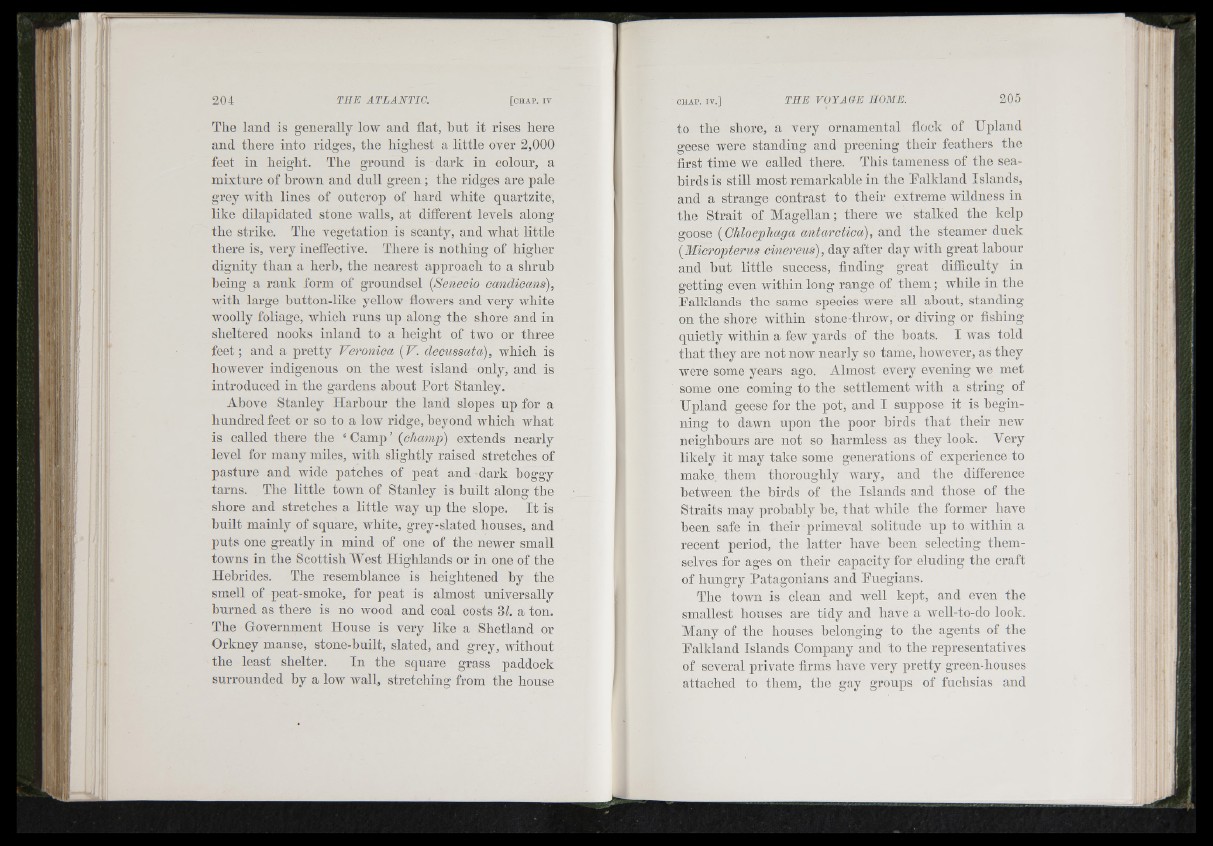
I■' il s „
'II Ii i
I ’
.'„SJ »!
M
ii
:!i
# 1 r V i Ü
. " 11:
' fi
é ü :
I ur
- 'Ii,
'J ill
204
The land is generally low and flat, hut it rises here
and there into ridges, the highest a little over 2,000
feet in height. The ground is dark in colour, a
mixture of hroAA'n and dull g re en ; the ridges are pale
grey with lines of outcrop of hard white quartzite,
like dilapidated stone walls, at different levels along
the strike. The vegetation is scanty, and Avhat little
there is, very ineffective. There is notliing of higher
dignity th an a herb, the nearest approach to a shrub
heing a rank form of groundsel (Senecio candicans),
vdth large hutton-like yellow flowers and very white
woolly foliage, Avhich runs up along the shore and in
sheltered nooks inland to a height of two or three
feet; and a pretty Veronica [V. decussata), which is
hoAvever indigenous on the Avest island only, and is
introduced in the gardens ahont Port Stanley.
Above Stanley Harbour tbe laud slopes up for a
Imndred feet or so to a Io a v ridge, beyond Avhich what
is called there tbe ‘ Camp ’ {champ)) extends nearly
level for many miles, with slightly raised stretches of
pasture and Avide patches of peat and dark boggy
tarns. The little toAvn of Stanley is built along the
shore and stretches a little Avay up the slope. I t is
built mainly of square, Avhite, grey-slated houses, and
puts one greatly in mind of one of the newer small
towns in the Scottish AVest Highlands or in one of the
Hebrides. The resemblance is heightened hy the
smell of peat-smoke, for peat is almost universally
burned as there is no Avood and coal costs 3/. a ton.
The Government House is very like a Shetland or
Orkney manse, stone-huilt, slated, and grey, Avithout
the least shelter. In the square grass paddock
surrounded by a low Avail, stretching from the house
to the shore, a very ornamental flock of Upland
geese were standing and preening their feathers tbe
first time we called there. This tameness of the seabirds
is still most remarkahle in the Palkland Islands,
and a strange contrast to their extreme wildness in
the Strait of Magellan; there we stalked the kelp
goose {Ghloepliaga antarctiea), and the steamer duck
{Micropterus cinereus), day after day Avith great labour
and h u t little success, finding great difficulty in
getting even Avithin long range of th em ; AA'hile in the
Palklands the same species Avere all about, standing
on the shore within stone-throw, or diving or fishing
quietly within a feAV yards of the hoats. I was told
th a t they are not now nearly so tame, hoAvever, as they
were some years ago. Almost every evening we met
some one coming to the settlement Avith a string of
Upland geese for the pot, and I suppose it is heginning
to dawn upon the poor hirds th a t their u c a v
neighbours are not so harmless as they look. Very
likely it may take some generations of experience to
make^ them thoroughly Avary, and the difference
between the birds of the Islands and those of the
Straits may probably be, th a t Avhile the former have
heen safe in their primcA'al solitude up to within a
recent period, the latter have been selecting themselves
for ages on their capacity for eluding the craft
of hungry Patagonians and Puegiaiis.
The toAAui is clean and Avell kept, and even the
smallest houses are tidy and have a Avell-to-do look.
Many of the houses helonging to the agents of the
Palkland Islands Company and to the representatives
of several private firms have very pretty green-houses
attached to them, the gay groups of fuchsias and